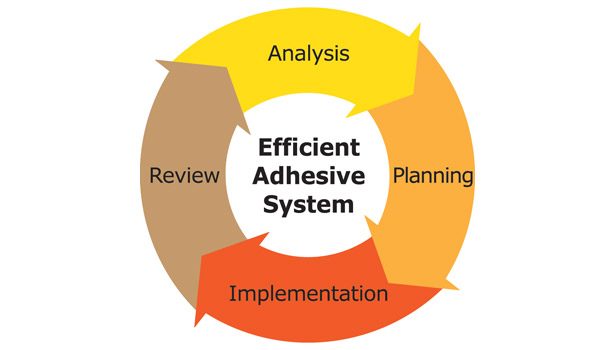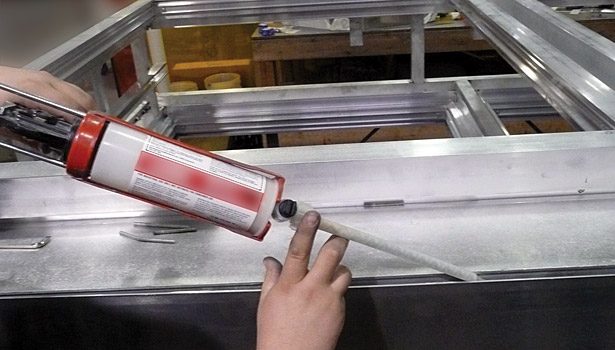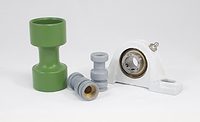"Added value” is not just an overused buzzword in today’s business and manufacturing environment. It can actually be the key driver in profitability when
| Jump to: |
incorporating adhesives into a manufacturing process. When done right, adding adhesives to a process can provide much more value than the traditional advantages of better quality, improved aesthetics, expanded design capabilities or improved performance. Adhesives can also reduce labor and floor space requirements while improving throughput.
The changeover to using adhesives as an alternative to other joining methods (e.g., mechanical fasteners, welds, rivets or tapes) can be a low-risk process—if you work with an adhesives supplier that offers a strong support system. Support can come in many forms, but one of the most functional methods is the concept of systems engineering.
In broad terms, systems engineering is a study of the methods by which all system elements are designed, organized, and related to optimize a specific function based on prioritized goals and needs. A successful systems engineer will separate the functional requirements of an application from the manufacturer’s overall needs and goals, and work toward implementing a system that not only meets these functional requirements but maximizes the value to the manufacturer by keeping these pre-defined goals as the focus of the overall system design.
A systems engineer’s knowledge can reduce risk, ensure the conversion to adhesives is done right the first time and address problems before they happen. They can help with equipment selection and setup, design assistance, workflow, and personnel training.
The Systems Engineer
At the core of any successful systems engineering process is the systems engineer, who provides the link between a manufacturer’s facility, the adhesives supplier and any external vendors. The main goal of the systems engineer in integrating a structural adhesives system is risk mitigation, making sure the switchover to adhesives is done right the first time and helping the customer address problems before they occur.
During the switchover, the systems engineer will also assist manufacturers with issues related to cost, quality and production rate. While any adhesives supplier can show you how to take two substances and stick them together, only a systems engineer can design and organize a system that will take you from prioritizing your needs to production design and implementation, while providing ongoing support. The correct application of systems engineering principles can deliver a number of value-added benefits.
Managing Culture Change
Many manufacturers are transitioning from welding, riveting, or other means of mechanical fastening. They have experience and a general familiarity with these joining methods, but not necessarily with adhesive bonding. The systems engineer can ease the transition to a new joining method and help manufacturers that may be hesitant to change or unfamiliar with the processes for structural adhesive bonding become more comfortable.
Risk Mitigation
Do it right the first time. Manufacturers are investing time and money into the transition, and systems engineering can help reduce/eliminate costly problems before full production. Reduced design changes, reduced lead time, improved reliability and reduced introduction costs are a few of the pre-production benefits that can be realized.
Added Value
Use the transition from mechanical fastening to adhesive bonding as an opportunity to solve existing problems and/or achieve corporate goals through proper systems design.
Focused Goals
Meeting manufacturer needs and goals on top of the functional benefits associated with adhesive bonding are the main components of systems engineering. The manufacturer’s goals could be to increase output (reduce cycle time), improve quality or reduce costs. It is these goals—prioritized by the manufacturer—that drive the system design.
For example, a company that joins sidewall panels for automotive assembly might be interested in switching from mechanical fasteners to structural adhesives. In this case, if the manufacturer’s priority is improved quality, a series of in-process inspection points may be designed into the system. Alternatively, if the manufacturer’s priority is to increase the amount of panels they build per day to improve production output, these added inspection points would likely not be considered due to the added time constraints. The systems engineer will review the manufacturer’s needs and develop a process to achieve their specific goals.
Key Principles
In general, systems engineering principles apply to all manufacturers generically, although specific needs and goals are unique to the individual customer. Systems engineering is adaptable to both large- and medium-sized operations. Smaller operations can reap the benefits of just a few systems engineering methods, while bigger, automated facilities might require a complete systems setup.
Defining Customer Goals
The systems engineer will begin the process by initiating a dialogue with the customer to define their specific needs and functional requirements. This first stage explores current processes and cost drivers, and prioritizes goals and future needs. Some of the questions a systems engineer will ask include:
• What are your priorities?
• What do you value most in your operations?
• What will add the most value?
• What problems/bottlenecks are you having?
The systems engineer will review the current process and product design, and formulate a measurable solution based on the manufacturer’s needs. A general theory of how structural adhesives can benefit the manufacturer’s operations will be provided. This theory will contain several options, allowing the manufacturer to accurately gauge the advantages of using adhesives.
As an example, a manufacturer that is currently performing small assembly functions requiring manual dispensing of adhesives at multiple workstations will be shown how to save time and money by using an automated dispensing method for bulk adhesives and consolidating the assembly functions to one area.
Integrating Structural Adhesives
Once the manufacturer’s needs and goals are documented and prioritized and the current process has been reviewed, the systems engineer will work with the manufacturer to outline the process for the new structural adhesives system. During this phase, the systems engineer will identify specific areas where the integration of the adhesives system can provide the greatest value to meet the manufacturer’s needs and goals.
At this point, the systems engineer will begin to create a viable plan for implementing structural adhesives into the production environment. This brainstorming session allows the manufacturer to respond to the feedback garnered from the initial process reviews. Together, the systems engineer and the manufacturer will consolidate these concepts into a prioritized project, keeping the manufacturer’s goals in mind.
Testing is an important aspect in the implementation of a structural adhesives system. In-plant trials will allow manufacturers to experience the benefits of using adhesives compared to their previous joining methods. Testing with various substrates, adhesive formulations, fixturing methods and surface preparation techniques will ensure the best output with the least amount of trouble.
Production/Utilization Process
The final plan is realized as the systems engineer begins to roll out the solution for integrating structural adhesives into the production process. During this phase, equipment will be installed, training will be done and test trials will be performed—all with the goal of meeting the manufacturer’s needs.
A proficient systems engineer will have good relationships with outside vendors—such as equipment suppliers, design specialists, and shipping and receiving
The final plan is realized as the systems engineer begins to roll out the solution for integrating structural adhesives into the production process. |
experts—to provide an entire workable system for the manufacturer. They will also work internally with their own support team, including distributors, testing technicians and quality control personnel, to deliver the best possible service for adhesives implementation.
One of the systems engineer’s prime objectives is to help the manufacturer understand the working concept of a structural adhesives system, wherein one job function directly relates to and affects the next job function. This is where education and training become important. Each worker must understand how their job task, if done properly, will make the whole systems operation successful and produce a good product. Conversely, if one task is not handled correctly, it will negatively impact the final product outcome.
For example, if a component is not cleaned and prepared properly, it can affect the adhesive’s bonding properties. Components must move seamlessly throughout the bonding process to ensure a properly bonded finished product. The systems engineer will oversee the training process, both on the individual level for each worker and on the entire system for quality control personnel. The manufacturer will be shown how to create work instructions for each task, how to design and use fixturing equipment, and how to determine when a bond is done correctly. Finally, the systems engineer will inspect the entire system to make sure all manufacturer needs have been met.
Support and Evaluation
After implementation is complete and verified to be operating efficiently, the systems engineer will return to the manufacturer and perform an audit to monitor the production process and confirm that initial outputs are being maintained. Continual support will be provided to ensure systems capability throughout the lifecycle of the adhesives operation.
Systems Engineering in Action
The following case study provides an example of how systems engineering can save time and floor space for a manufacturer interested in using structural adhesives. The manufacturer, a door equipment supplier, originally used heat/pressure-cured epoxy tape to join aluminum door skins to aluminum frame members. After reviewing the assembly process, the systems engineer assessed the manufacturer’s problems and defined their needs. The customer’s main priorities were to reduce and improve cycle time (increase throughput) and to increase and optimize floor space.
The existing process required nine steps to complete a door assembly, including a series of sub-processes, such as transportation between stations and maintenance of ovens, as well as acid and rinse tanks.
The tape itself also had its own set of unwieldy requirements. Because the tape requires storage in a freezer to maintain shelf life, it had to be applied on a heated surface in order to adhere during initial assembly. A 90-minute post-assembly baking process was also needed to cure the tape. This baking process, however, caused the epoxy to drip, which necessitated grinding the drip off the finished product.
The systems engineer ascertained that the door manufacturer would save a considerable amount of time and floor space by switching to structural adhesives as a joining method. By reducing the cycle time per door from 79 to 33 minutes, production could be increased by approximately 240%.
A significant amount of floor space could also be gained by removing the acid etch area, the epoxy tape bonding area with the heated table and freezer, the post-bond curing oven, and the grinding station. Instead, all of the processes for the adhesive bonding operation could occur at one station, approximately equal to the size of the current assembly station.
With systems engineering, the manufacturer was able to eliminate several cost drivers not included in the time/comparison study. These included the cost of acid etch media and disposal of the acid every six weeks; overhead to operate the etch system, the heated table, the freezer, and the oven; etch process flush and fill every six weeks (a one- to two-day process); a daily 17-step inspection process for pH levels in each tank (about one-half hour at the start of each day); and the cost of grinding equipment such as sanding discs and grinding tools.
The systems engineer showed the manufacturer how, after switching to structural adhesives, the clamped/fixtured door could be staged directly into a rack for storage immediately after bonding. The cure time for the adhesive (estimated at 72 minutes to handling strength and 24 hours to full cure at room temperature) would not delay production or factor into the production rate. As a result of the systems engineer’s evaluation, the manufacturer reviewed the proposed changes and has successfully implemented them.
A Valuable Service
Partnering with an adhesives supplier that offers systems engineering services is an ideal way for a company to reap the benefits of both structural adhesives and an optimal production plan. Almost any manufacturer interested in switching to structural adhesives can take advantage of systems engineering, including those who:
• Would like to change over to adhesives but are concerned implementation might be costly or too difficult
• Currently use adhesives but are interested in upgrading, modernizing or improving their systems
• Need to show added value to increase, maintain or acquire business
A systems engineer does more than just support a product sale. With proper systems engineering, problems can be solved, goals can be met and costs can be reduced while production is optimized. By choosing a supplier that offers a systems engineering program, manufacturers not only gain the “added value” of using structural adhesives, but also the “extra-added value” of a systems engineer.
For additional information, call (877) 275-5673 or visit www.lord.com.
Listen to our podcast with the author!





.jpg?height=200&t=1653417027&width=200)